Review by W.A. Demers;
Catalog Photographs Courtesy of Crocker Farm
SPARKS, MD. — It is probably fitting that an exceptional stoneware water cooler with profuse incised federal eagle motif and attributed to Baltimore, Md., potter Henry Remmey, circa 1812–29, now resides in the Manhattan apartment of collector Jerry Lauren, brother to Ralph and executive vice president and creative director of men’s design for Ralph Lauren Corp. After all, its makers — father and son Henry Remmey Sr and Jr — brought their potting, decorating and firing skills acquired in Manhattan, the leading style center of American stoneware production in the Nineteenth Century, to Baltimore when they arrived there in 1812.
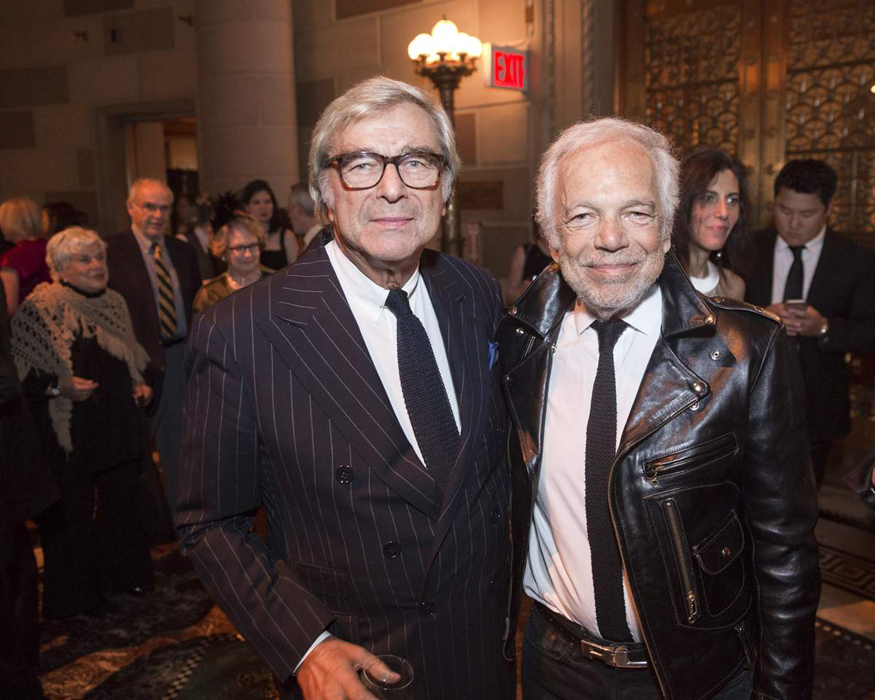
Jerry Lauren, left, and Ralph Lauren at the October 15 gala at the American Folk Art Museum where Jerry Lauren was saluted as a leading collector of American folk art and self-taught art.
Courtesy of the American Folk Art Museum.
“I am thrilled,” Lauren told Antiques and The Arts Weekly, two days after he successfully bid $483,000 to win the piece at Crocker Farm’s October 17 stoneware and redware auction, “especially coming two days after I was feted at the American Folk Art Museum.” It turned out to be a good week for Lauren, as he was honored at the October 15 event for his contributions and his personal art collection — which now has a new record holder. “I guess I can’t buy everything that comes along, but when I have, I always seem to achieve a new record,” said Lauren, who last reached bidding high ground at Crocker Farm in July 2014 when his return volley for a Civil War churn uniquely decorated with four Union soldiers marching in formation succeeded at $402,500. (That was a record with an asterisk, because the Civil War soldiers churn sold at hammer price $350,000, plus 15 percent buyer’s premium. Previously a Connecticut eagle jug sold at another auction house for $340,000, plus 18½ percent buyer’s premium, or $402,900 — $400 more when taking the higher buyer’s premium into account.)
No asterisk needed for the Remmey cooler, a fresh-to-the-market example that was purchased for about $500 by the consignor’s father at a Pennsylvania estate auction in 1974. It was anticipated to soar, although Crocker Farm principal Tony Zipp admitted that he was nervous as he began the sale. He opened the lot to a Baltimore collector at $100,000. It then was taken to $180,000 by Florida stoneware collector Martin Kaye, then back to Lauren at $190,000. At the $200,000 level Pennsylvania antiques dealer Kelly Kinzle entered the fray and hung on to become the underbidder when the price reached $420,000. “It was the best piece of stoneware I’ve ever had my hands on,” said Kinzle, who was at the sale. “You have to see it in person to appreciate it. Photos don’t do it justice.” Kinzle added that he was bidding with an aspiration to win it for his upcoming display at the Winter Antiques Show. “That was not to be, but one of my target customers for that show ended up being the winner.”
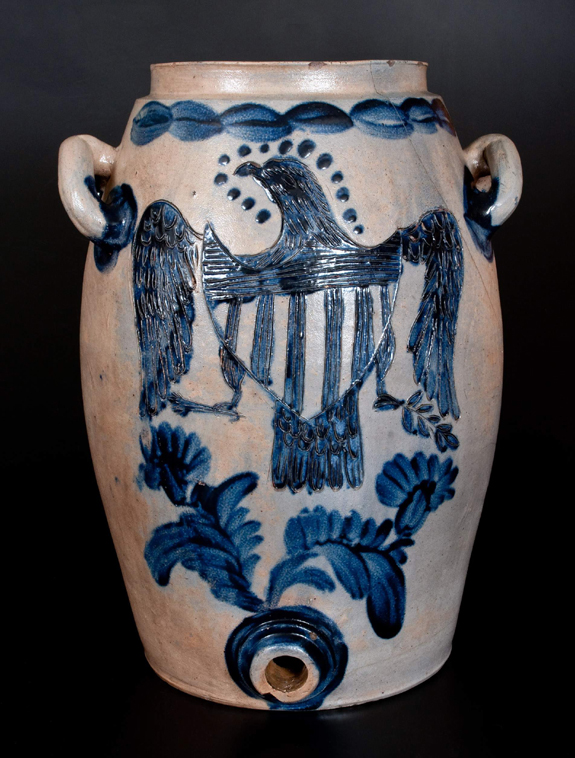
The rare and probably unique 7-gallon stoneware water cooler attributed to Henry Remmey Sr or Jr, Baltimore, Md., circa 1812–29, was pushed by determined floor and phone bidders to a record $483,000. New York collector Jerry Lauren claimed the vessel.
More than tripling its high estimate of $125,000, the Remmey cooler, as is Crocker’s tradition, was the first lot presented, and a full-house crowd numbering well over 150, with spectators lined up along the upper loft as well, applauded the cooler’s performance. And why not? Considered probably unique, the 7-gallon cooler fairly bristles with incised and cobalt-highlighted federal eagle decoration, the execution of which is attributed to Henry Remmey Sr or Jr. The cooler is large and ovoid with a stepped bunghole and open handles featuring added supports because of its size.
“With its striking figural design and outstanding cooler form, this recently surfaced work ranks as arguably the finest American stoneware object to come to auction since the iconic William Crolius inkstand set a then-record price for the medium at Sotheby’s in 1991,” said Zipp.
Catalog notes trace the quality and style of the incising, the color of both the clay and cobalt slip and the cooler’s distinctive floral motifs to the shop of William Myers where Remmey worked as factory superintendent. “The two flowers emanating from the top of the bunghole make this a dead ringer for stoneware produced at Myers,” said Zipp. New York-trained potters Henry Remmey Sr and his son Henry Harrison Remmey arrived in Baltimore from Manhattan in 1812, virtually changing the quality and reputation of the city’s stoneware craft overnight.
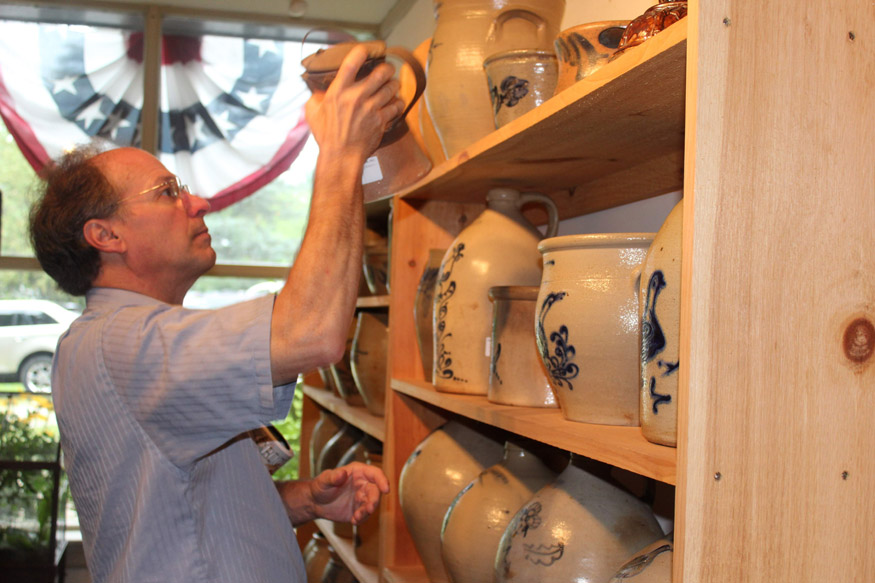
Pennsylvania dealer Kelly Kinzle, shown here examining stoneware offerings at Crocker Farm’s July 2015 auction, was the underbidder for the Remmey cooler.
The cooler’s surface is lavishly decorated with an incised and cobalt-highlighted eagle design. In addition, the eagle appropriates the federal style with a spread-winged stance and shield across its chest, its talons clutching olive branches and arrows. It adapts the design of the Great Seal of the United States, the catalog noting that the cooler’s maker clearly copied the reverse of a coin in circulation at the time in which engraver Charles Sims’s “heraldic eagle” appeared on the reverse of $5 gold pieces minted from 1796 to 1807.
Among the small number of other incised Remmey pieces from Baltimore that have survived, this cooler excels in its grandeur and decorative quality. Said Lauren, “I have carefully selected the pieces in my collection and they number only five or six, but on a scale of one to ten, each always measures a 12. I would rank this cooler at the top of my collection.”
Other Highlights
Crocker Farm rattled the record books this past July when it sold a rare alkaline-glazed stoneware face jug with Edgefield, S.C., origin, circa 1860, that had been purchased at a yard sale for $1.50 by a New Jersey woman. It soared to reach a world auction record for that form at $92,000. For this sale, the firm presented three or four more of the folky jugs. Realizing $46,000 was a rare alkaline-glazed stoneware harvest face jug with an Edgefield origin, circa 1860–70, featuring a wheel-thrown form with applied trumpet-form spout and arched handle, raised eyelids, kaolin eyes and teeth, a nose with carved nostrils and large well-formed ears. And right behind it, at $33,350, was the next consecutive lot, a rare Edgefield stoneware face jug, possibly from Lewis Miles’ Stoney Bluff Manufactory, circa 1860–70.
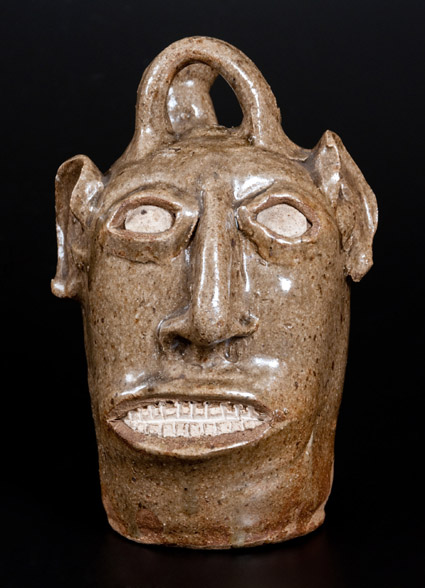
Realizing $46,000 was this rare alkaline-glazed stoneware harvest face jug with an Edgefield origin, circa 1860–70.
Fetching $23,000 was a possibly unique figural stoneware bank attributed to the J.L. Mathews Pottery, Rock Mills, Ala., 1890–1910. The wheel-thrown bank was in the form of a man attired in a coat with applied face and arms, holding a bell-shaped urn, perhaps to receive money. In its catalog, Crocker Farm said “this extraordinary example of Southern folk pottery is one of the finest American stoneware banks we have seen.” It was discovered in the attic of a home in Alabama, wrapped in a quilt.
An exceptional Edgefield ovoid stoneware jug with two-colored decoration and a bold numeral 3, attributed to the C. Rhodes Factory, Shaw’s Creek, circa 1850, sold for $17,250.
Figural pieces continued to lead in the sale as a large stoneware drunken monkey figure, Southern or Midwestern, circa 1885, brought $11,500. Seated on a stepped plinth, the top-hatted figure clutches a wheel-thrown jug in one hand and fondles himself with the other. “This highly unusual sculpture appears to be a humorous commentary on the evils of alcohol consumption, possibly related to the Temperance Movement,” stated the catalog, further speculating that the hollow interior of the hat may have allowed it to serve as a match safe.
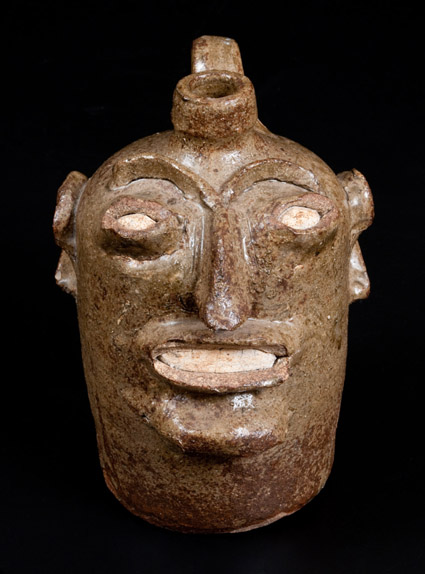
A rare Edgefield stoneware face jug, possibly from Lewis Miles’ Stoney Bluff Manufactory, circa 1860–70, sold for $33,350.
Finishing at $12,650 was a rare 1-gallon stoneware jug with cobalt cat decoration, stamped “Cowden & Wilcox / Harrisburg, Pa,” circa 1865. The cylindrical jug with tapered spout was decorated with a slip-trailed design of a cat with pointed ears and curled tail, seated atop a brushed oval ground.
Overall, this was Crocker Farm’s fourth million-dollar sale. Prices reported include the buyer’s premium. The firm’s next auction will be conducted in March and it is now accepting consignments. For information, 410-472-2016 or www.crockerfarm.com.

